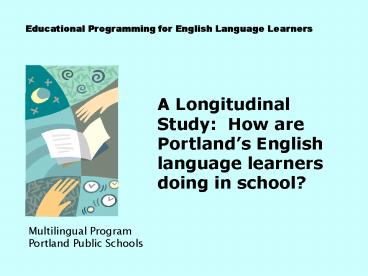Multilingual Program Portland Public Schools PowerPoint PPT Presentation
1 / 19
Title: Multilingual Program Portland Public Schools
1
Educational Programming for English Language
Learners
A Longitudinal Study How are Portlands English
language learners doing in school?
Multilingual Program Portland Public Schools
2
Longitudinal Study
- Purposes
- To determine the effectiveness of the program
in exiting students successfully into the
mainstream - To identify students receiving ESL services
after five years and develop strategies for
accelerating their learning - To evaluate data collected by the district in
terms of its sufficiency in (1) meeting
accountability requirements, and (2) determining
program effectiveness in promoting students
English language acquisition, academic content
preparation, and ability to meet high standards - To discover how well our data correlates with
major research findings on English language
acquisition
3
Cohort Group
1999-00 Newly-Enrolled Registrants at
Intake Center 261 Students
Grade Level Placements Kindergarten
75 Grade 1 26
Grade 2 15
Grade 3 13
Grade 4 13
Grade 5 20
Grade 6 12 Grade
7 11 Grade 8
16 Grade
9 36 Grade 10
8 Grade 11
9 Grade 12 7
Gender Females 128 Males 133
Ethnic Categories Asian 75 Black
119 Hispanic 19 White
49
4
Language Groups
Acholi 14 Albanian 5 Amharic
1 Arabic 16 Azande 6 Bulgarian 3 Cantonese
8 Creole 1 English Dialect 8 Farsi
5 French 12 Japanese 1 Khmer 26 Korean 1
Mandarin 1 Nuer 10 Pashto 1 Persian 1 Punja
bi 1 Romanian 1 Russian 11
Serbo-Croatian 21 Somali 55
Spanish 19 Swahili 1 Tagalog 1 Tamil 1
Thai 2 Tigrinya 1 Tshiluba 3 Vietnamese 2
5
5
Current Status of the Cohort Group
Active 132 Inactive 129 Dropped Out
14 Moved 76 No show 10 Graduated
29 GradML 14 GradRC 15
6
Profile of 132 "Active" Students
Ø English Language Proficiency Placement
Results
Language Assessment Scales (LAS)
Oral Non-English Speaker (NES) 77
students Limited English Speaker (LES) 26
students Intermediate English Speaker (IES) 29
students Language Assessment Scales (LAS)
Reading/Writing Non-literate (NL) 118
students Limited Literate (LL) 8
students Intermediate Literate (IL) 6 students
7
How long does it take to exit from the ESL
program?
According to Research
Findings of Virginia Colliers Longitudinal Study
- ENGLISH Language Learners (ELLs) with no
schooling in their first language take between
seven (7) to ten (10) years to reach the language
proficiency of native English-speaking peers. - ELLs with two or three years of schooling in
their native language take between five (5) to
seven (7) years.
8
Age and Schooling For Foreign Born Language
Minority Students
Age of entry into U.S. School 5-7 years At
risk. Home language not fully acquired. 8-12
years Optimum age. Home language fully
acquired, to serve as foundation for learning
English as a second language. 13-18 years At
risk. Not enough time left in school to catch up
with mainstream English-speaking peers if
literacy in home language is not at grade level.
9
Results of Portland Public Schools Study
10
PPS LONGITUDINAL STUDY FINDINGS
Based on Grade Level
10 Months 1 Academic Year
11
PPS LONGITUDINAL STUDY FINDINGS
Based on Oral English Language Proficiency Level
Social/Conversational English Only
NES Non-English Speaker LES Limited
English Speaker FES Fluent English
Speaker (Vocabulary of
approximately 500 words) Categories based on
Language Assessment Scales (LAS) Oral
12
PPS LONGITUDINAL STUDY FINDINGS
Based on English Language Literacy Level
NL Non-literate (118) LL Limited
literate (8) IL Intermediate Literate
(6) Categories based on
Language Assessment Scales (LAS) Reading/Writing
13
PPS LONGITUDINAL STUDY FINDINGS
Full Time ESL (30) NES 27
LES 3 IES 0 Partially Mainstreamed (14)
NES 9 LES 2 IES 3
14
PPS LONGITUDINAL STUDY FINDINGS
Total number of students in the cohort with
preschool experience 27
Average Stay in the Program
15
PPS LONGITUDINAL STUDY FINDINGS
2002-03 Grade 3 Average Terra Nova DPME
DPME (1) Does not Meet, (2) Partially Meets,
(3) Meets, (4) Exceeds Standards
16
PPS LONGITUDINAL STUDY FINDINGS
There were 29 Students in the cohort who
graduated. We were able to contact 23 of them.
What are they doing now?
17 College 4 Working 1 Some
College 1 At home
Students going to college Deering 71 Portland
76
80 of the cohort high school graduates, whom we
were able to contact, went on to college.
17
LONGITUDINAL STUDY FINDINGS
What does the data mean? IMPLICATIONS
1. A percentage of the language minority
population is non-English speaking (60 of the
cohort) and non-literate in English (90 of
cohort). 2. Language minority students are a
transient population. 3. The amount of time for
language minority students to receive ESL support
is below the national average.
18
4. Eighty percent (80) of graduating language
minority students go on to post- secondary
education. 5. Overall, the ESL support program
does an excellent job in preparing language
minority students for mainstream learning. 6.
Although language minority students meet exit
criteria as indicated by the LAU Plan, they still
need continued support. 7. Preschool readiness
has an enormously positive impact on language
minority students (as much as one year).
19
8. Quality ESL support at the high school level
increases the accessibility of language minority
students for post-secondary education (17 out of
23 contacted h.s. grads in longitudinal
study.) 9. All language minority students need
ongoing, consistent access to regular cognitively
challenging academic curriculum in order to
improve their competence in math, reading, and
writing. 10. Mainstream teachers need to learn
more about strategies, techniques, and activities
of comprehensible learning in order to help them
with all struggling (i.e., language impoverished)
students.

